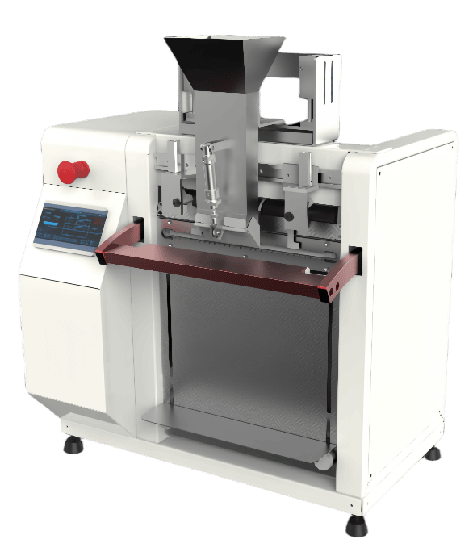When you bag stuff manually, it’s not consistent, it’s more expensive, and it takes longer. This can lead to lost profits and delayed operations. Automatic bagging machines are the solution.
The advantages of automatic bagging machines include enhanced speed, reduced labor costs, improved accuracy, minimized material waste, and scalability. These machines streamline operations, ensuring consistent packaging quality while reducing human error.
Next, we’ll look at the advantages of using these automatic bagging machines.

Improved Efficiency and Speed
Automatic bagging machines offer significantly faster operation compared to manual methods. They can process multiple items within seconds, making them ideal for high-volume production environments. This increased speed allows businesses to meet larger production demands without compromising on quality.
In addition to faster output, automatic bagging machines minimize downtime. Since these machines can operate continuously without the need for breaks, they greatly enhance overall operational efficiency, leading to better fulfillment rates and improved customer satisfaction.
Reduction in Labor Costs
One of the biggest advantages of switching to automatic bagging machines is the significant reduction in labor costs. By automating the packaging process, companies can drastically cut down on the number of workers required to oversee production. This directly lowers operational expenses and improves profit margins.
Additionally, these machines reduce the need for constant supervision and training, freeing up human resources for more critical tasks like quality control and customer service. This not only cuts costs but also increases overall productivity within the workforce.
Enhanced Packaging Accuracy
Automatic bagging machines provide a high level of accuracy when it comes to packaging. They ensure that every bag is filled with the correct amount, maintaining consistent product weights and sizes. This precision prevents overfills or underfills, helping companies avoid product waste and stay compliant with industry standards.
Equipped with advanced sensors and scales, these machines guarantee that the right amount of product is dispensed into each bag. This level of accuracy improves product presentation and reduces the risk of errors that could lead to customer dissatisfaction.

Minimized Material Waste
With precise controls over packaging materials, automatic bagging machines help reduce waste. Manual processes can lead to excess use of packaging materials or improperly sealed bags, resulting in unnecessary costs and environmental impacts.
Automating the bagging process ensures that materials are used efficiently, with the correct amount of packaging for each product. This reduces waste, helps control costs, and contributes to more sustainable business practices, which is increasingly important in today’s market.
Improved Scalability
As businesses grow, so do their packaging needs. Automatic bagging machines are built to scale with increased production demands. Whether the production volume fluctuates or expands rapidly, these machines can easily adapt to handle larger quantities without sacrificing efficiency or accuracy.
This scalability makes automatic bagging machines an ideal solution for industries that experience seasonal spikes in production, such as food processing, pharmaceuticals, and retail packaging.
Consistent Packaging Quality
Maintaining consistent packaging quality is a challenge in manual operations, often leading to customer complaints due to discrepancies. Automatic bagging machines eliminate this issue by delivering uniform bag sizes, accurate fills, and proper sealing on every package.
This consistency in packaging enhances the visual appeal of the product, improves shelf life, and ensures that businesses comply with regulatory requirements. A reliable, uniform appearance helps in building trust with consumers and strengthens brand loyalty.

Reduced Risk of Injuries
Manual bagging processes involve repetitive motions that can lead to worker fatigue and increase the risk of injuries. Tasks like lifting heavy bags, sealing, and repetitive arm movements can cause strain and long-term injuries.
Automatic bagging machines significantly reduce these risks by automating the more labor-intensive aspects of the process. This reduction in workplace injuries lowers compensation claims and insurance costs while creating a safer environment for workers.
Integration with Other Systems
Many automatic bagging machines are designed to integrate seamlessly with other automation systems such as conveyors, sorting machines, and palletizers. This integration allows companies to create a fully automated packaging line, boosting overall productivity and reducing bottlenecks.
By streamlining these processes, businesses can achieve a more efficient operation, improving output and maintaining high-quality standards throughout the production line.
Lower Error Rates
Human error is inevitable in manual bagging operations. Automated systems, however, eliminate these mistakes, ensuring the correct product, weight, and packaging for every item. This drastically reduces the chances of mislabeling, inaccurate fills, or defective packaging.
By reducing errors, businesses not only save on costs associated with rework and product returns but also enhance customer satisfaction by delivering reliable, high-quality products consistently.
Environmental Benefits
Automatic bagging machines also offer environmental advantages. They optimize the use of packaging materials and reduce waste, which helps companies lower their environmental footprint. In addition, many machines use recyclable materials, contributing to sustainability initiatives.
By reducing energy consumption and material waste, companies can meet their sustainability goals, appeal to eco-conscious consumers, and comply with environmental regulations, which is increasingly vital in modern business.
Conclusion
Automatic bagging machines are great for people who want to bag things faster, cheaper, and better. If you’re looking to scale and optimize your bagging operation, these are a fantastic solution.
You may be interested:









